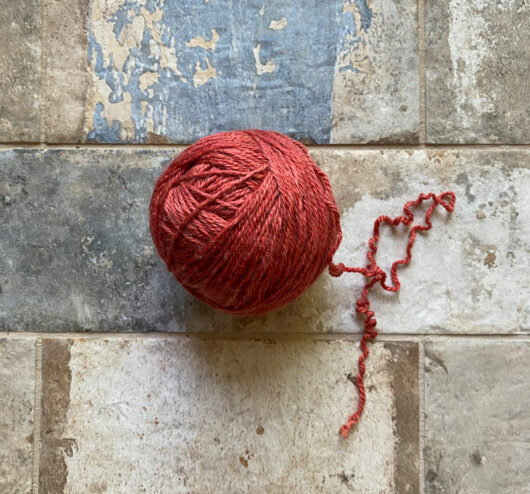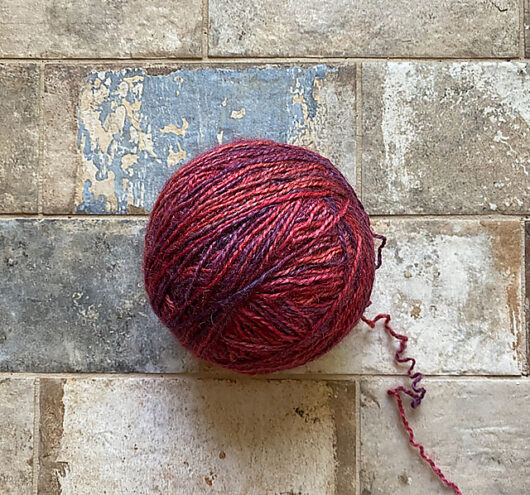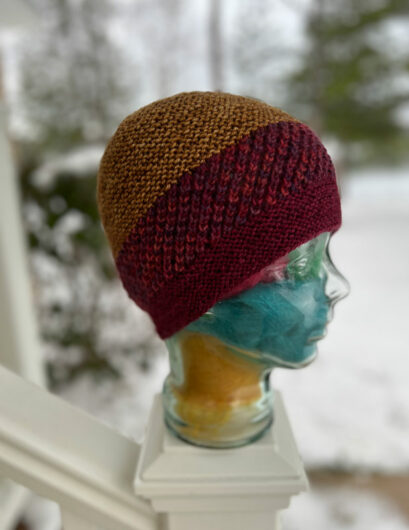
These are Susan Mills Mitered Mittens. It’s the 4th time I’ve knit them and they are tons ‘o fun to work up. I used Bluefaced Leicester Aran Prints by West Yorkshire Spinners. I’ve worked with this yarn before though not in this colorway. The patterning is reliably consistent. But it’s a worsted weight, not an Aran, to my way of thinking. Which made it perfect for this pattern.
These may look complicated but they’re easy–with one challenge (more on that later). They are knit flat in garter stitch.There’s one long seam on the edge opposite the thumb. And there’s a thumb seam on the inside of the thumb. Have you figured out yet how the mitten is formed? You work bottom up, through the thumb gusset. When the gusset’s complete you put the mitten stitches on a holder and complete knitting the thumb. With all the stitches back on the needle, you cast on stitches at each edge. Those stitches get “pulled in” by the centered double decrease–with some extra shaping at the top of the fingers–until the mitten is completed.
It’s totally fun and very ingenious.
About that one challenge: it’s keeping the double decrease centered. The instructions are to use a removable marker to clue you in on when to start the decrease. I’ve probably not confessed this before. I don’t get along well with removable stitch markers. I like to have my markers on my needles where they belong.
Keeping track of the mitered decreases wasn’t working for me until I ditched the suggested removable stitch marker. Instead, I put a “regular” stitch marker in place. Then I slipped the stitch before the marker, removed the marker, slipped the next stitch, knit the next stitch, passed the two slipped stitches over—and replaced the marker before the stitch just knit. Admittedly it’s a super clunky maneuver. And there’s the pesky problem of what to do with that stitch marker for the moment it takes to get it out of the way. Mostly I put the rubbery o-ring marker–don’t be grossed out–in my mouth. But at least I got my decreases in the right place. And I did wash the mitts before I put them into my gift stash.

I had enough yarn left to work up a sort of matching cap. It’s tincanknits Barley, with a sweet pompom added. Check here and here for other versions of Mitered Mittens. My only modification to the mittens was to work a 4″ cuff, which is a tad longer than the pattern suggests.
In this frigid cold and windy November and December, I’ve had lots of mittens on my needles. These next two pair are Elizabeth Zimmermann’s Mittens From the Top. I’ve been wanting to knit them for a long time. As is obvious from the name of the pattern, they’re knit from the top down. They are also knit flat in garter stitch.

I knit both this gold pair and the gray one below in Brown Sheep’s Lamb’s Pride Worsted. They are super warm. Exactly how warm? My brother’s stepson is a rural postal carrier. He chose this pair from my gift stash just before Christmas. Mr. Postman Nate has already asked if I can make him another pair because he “loves these things!”

We owe a lot to rural postal carriers. Another pair of mittens and maybe a matching hat is definitely something I want to do. Cold hands shouldn’t have to be part of the job. Nate is a non-knitter and he doesn’t know that camo ones would be a challenge. Plus I suspect what he most likes about these mittens is the warmth of the Lamb’s Pride mix of 85% wool 15% mohair. I’ve located some camo Aran weight wool yarn that might be warm enough. But I’m also considering simply knitting him a spare pair in some green-gray Lamb’s Wool I have in my stash.
Here’s that second pair of Mittens From the Top, this time in a nice heathered dark gray.

My pattern for this mitten is in Knit One, Knit All. I am fairly certain that my book version of this pattern has errors on the stitch count for the increases. You don’t get to the required 40 stitches at the top of the mitten with a k2, m1 worked all round. (Another Raveler has found the same problem.) This won’t make sense unless you’re working on the pattern, but at the end of the 1st increase, you need 18 stitches. After the 2nd increase you need 27. And after the 3rd one you’ll only get to the 40 required stitches if–when you get to the last 2 stitches–you k1, m1, k1. And I’m also fairly sure that you need to do the same at the last 2 stitches when you increase at the cuff to end up with the required 45 stitches.
I was really on a garter stitch mitten kick. I’ve knot nit oops not knit Elizabeth Zimmermann’s Sideways Mystery Mittens in a month of Sundays. So I had another go at this pattern, using Noro Silk Garden.

The way that the rows of color line up are the biggest clue for how these mittens are knit. The most I can say is that when you follow the instructions exactly as they are written you end up with a mitten. Really. The design of these is so odd that you end up losing confidence that a mitten can result. They’re not any kind of mitten until right at the very end. And then they are. Here’s another pair I’ve knit. Great fun!
If you have the time, consider knitting some mittens. Warm hands, warm heart. And I forgot to mention that each of these mittens fit either hand. You might even want to consider knitting them in sets of three because, of course, a day will come when one mitten decides to go AWOL.












